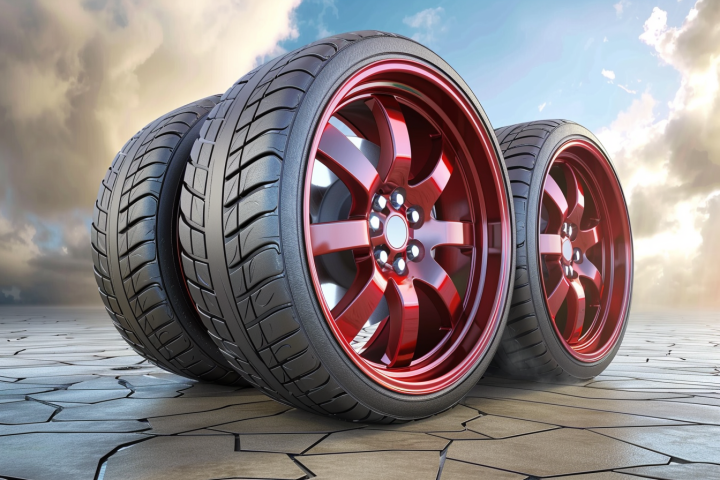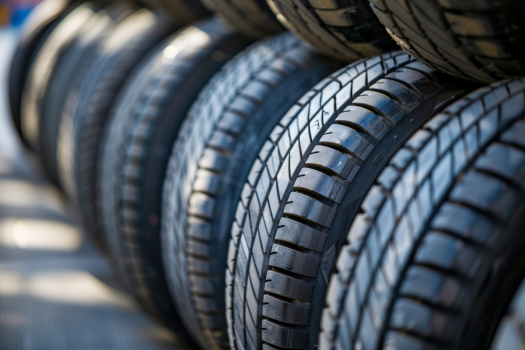Last Updated on April 21, 2024
Tire Sizes: Understanding the Basics of Tire Dimensions
The world of automotive tires is vast and varied, with many sizes and types available. Understanding tire sizes is crucial not only for vehicle maintenance but also for enhancing overall performance and safety. This section delves into the basics of tire dimensions and their role in vehicle performance.
The Role of Tires in Vehicle Performance
Tires are essential to vehicle performance, directly influencing handling, traction, and braking efficiency. They are also the primary contact point between the vehicle and the road, impacting fuel efficiency, ride comfort, and overall safety.
- Handling and Traction: Tires are a vehicle’s single point of contact with the road. Hence, they are crucial for handling and traction. The tire size and type considerably impact the vehicle’s handling characteristics, including cornering, braking, and acceleration.
- Safety: The correct tire size and type are critical for safety. Incorrect tire sizes can cause inadequate grip, longer stopping distances, and even tire failure. Appropriate tires guarantee that the vehicle performs as intended under various situations, including wet, dry, and icy roads.
- Fuel Efficiency: The tire size and tire type can affect fuel efficiency. More importantly, bigger tires may provide improved traction and increase rolling resistance, increasing fuel consumption. Conversely, smaller tires give less resistance but may compromise.
- Ride Comfort: The tire’s aspect ratio considerably impacts ride comfort. A higher aspect ratio indicates a thicker sidewall, which can better absorb road disturbances, resulting in a pleasant ride. Lower aspect ratios, while giving better handling, might make the ride seem stiffer.
- Environmental Impact: The size and structure of a vehicle’s tires impact its ecological footprint. Eco-friendly tires are intended to reduce rolling resistance, fuel consumption, and emissions.
Understanding tire sizes is more than just knowing the numbers; it is about understanding how these measurements affect a vehicle’s performance, safety, and efficiency. The proper tire size guarantees excellent performance, safety, and overall operational effectiveness.

Historical Overview of Tire Sizes
The evolution of tire sizes over time has been fascinating, distinguished by innovation, technological improvements, and shifting consumer demands. This article presents an overview of tire size history, focusing on early design advancements, tire size progression, and the variables influencing tire size diversity.
Early Innovations in Tire Design
Early innovations in tire design, such as introducing pneumatic tires and developing tread patterns, revolutionized vehicle performance and safety, setting the foundation for modern tire technology.
- Pneumatic Tires: In the late nineteenth century, John Boyd Dunlop invented pneumatic (air-filled) tires. This innovation significantly enhanced comfort and performance over previously utilized solid rubber tires. Pneumatic tires also introduced the concept of tire pressure, which expanded tire design and functioning.
- Tread Patterns: Initially, tire treads were bare, focusing on endurance. However, as automobiles became quicker and more ubiquitous, the requirement for better grip resulted in various tread patterns. These designs were created to improve grip, especially in severe weather situations.
- Radial Tires: Radial tires replaced the previous bias-ply type in the 1940s and were a big step forward. With their perpendicular steel belting, they provided better road contact, a longer life, and higher fuel efficiency. This style immediately became the standard for passenger cars.
Evolution of Tire Sizes Through the Decades
Tire sizes have varied substantially over the decades, from narrow, high-profile designs to more comprehensive, low-profile tires, reflecting changes in vehicle design, performance needs, and consumer preferences.
- Post-War Era: Tire sizes began diversifying after World War II as cars became more powerful and faster. More importantly, wider tires were developed to handle faster speeds while maintaining vehicle stability.
- 1960s and 1970s: The 1960s and 1970s saw the advent of low-profile tires and larger aspect ratios, which catered to sports cars and high-performance automobiles. A need for improved handling and speed drove these improvements.
- Modern Era: Today, there is a wide range of tire sizes to suit various types of vehicles, from small cars to large trucks. The introduction of SUVs and crossover vehicles has also led to the development of new tire sizes, combining aspects of passenger car tires with those of light trucks.
Evolution of Tire Manufacturing Processes
Tire manufacturing techniques have evolved from labor-intensive methods to highly automated and technologically advanced systems, boosting efficiency, consistency, and the capacity to produce a diverse range of tire types for various purposes.
- Decline in Mass Small Tire Market: The US market for mass-produced tiny tires, especially those with S- and T-speed ratings, high aspect ratios, and sizes of 13, 14, and 15 inches, is gradually shrinking. These tires are usually produced in large-scale factories with daily capacities ranging from 20,000 to 25,000.
- Historical Manufacturing Methods: These tire production methods were established when tire kinds and sizes were limited, and personalization in the car industry needed to be enhanced.
- Shift in Manufacturing Needs by 1984: By 1984, the growing variety of tire types indicated a need to rethink manufacturing processes. The goal was to produce a broader range of tires in shorter production runs, efficiently and economically, as discussed by Bajer in a 1984 guest editorial in Modern Tire Dealer.
- Innovative Manufacturing Processes by Michelin and Pirelli: Michelin’s C3M and Pirelli’s MIRS manufacturing processes are examples of this new approach. These systems are designed for lower total production volumes (about 3,000 tires per day or one million per year) but allow for greater variety and customization.
- Features of New Manufacturing Equipment: These new mini-plants use compact, software-driven automated tire assembly and curing equipment. They have quick installation, setup, and tooling modifications, with little human participation beyond monitoring and programming.
- Core-Built/Core-Cured Technology: Unlike previous processes, these systems combine core-built/core-cured direct tire component creation with simultaneous application technology.
- Elimination of Traditional Equipment: Traditional tire assembly and shaping drums, transfer rings, curing presses, and other high-energy-consuming machinery such as calendering and extruding lines are no longer required in these new processes.
This shift represents a fundamental transformation in tire manufacturing as it responds to changing market demands for greater variety and customization.
Factors Influencing the Diversity in Tire Sizes
A variety of vehicle designs drives tire size diversity. This is due to technological improvements, from compact automobiles to huge trucks, and consumer expectations for specific driving experiences and performance qualities.
- Vehicle diversity: As the automobile industry grew, so did the diversity of vehicles. Each vehicle type, from economical cars to heavy-duty trucks, requires a particular tire size to ensure the best performance and safety.
- Technological advancements: New materials and tire-building techniques have enabled a wider choice of tire sizes and varieties. These developments have made it possible to design tires for specialized applications, such as off-road, all-weather, or high-performance driving.
- Regulatory norms and Global Markets: As the automotive business has globalized, manufacturers must respond to varied market norms and preferences. This has contributed to the diversification of tire sizes.
- Consumer Preferences and Trends: The need for cars with specialized capabilities, such as off-road or sporty performance, has driven tire size evolution. Aesthetic preferences, such as the prevalence of giant rims, have also been a factor.
The history of tire sizes demonstrates the changing nature of automobile technology and consumer preferences. From the early days of solid rubber to the modern era of specialized pneumatic tires, the evolution of tire sizes reflects the ongoing pursuit of improved performance, safety, and efficiency in the automotive world.
The Expansion of Tire Size Varieties
The variety of tire sizes available today is a direct result of several converging factors, including technological advancements, vehicle diversification, and the impact of industry standards and globalization. This article explores these aspects in detail to understand how they have contributed to the current landscape of tire size varieties.
Technological Advancements and Their Impact
New developments in the automotive sector, such as electric vehicles and self-driving systems, are substantially impacting tire design. To satisfy these changing requirements, more durable, efficient, and specialized tires must be created.
- Material Innovations: Advances in rubber and synthetic materials have resulted in longer-lasting tires that are more efficient and adaptive to changing driving conditions. This material progression has resulted in a broader choice of tire sizes and varieties, including customized tires for various climates and driving conditions.
- Manufacturing Techniques: Advancements in manufacturing technologies have resulted in more exact and diverse tire sizes. Modern manufacturing technologies enable the creation of tires with precise dimensional tolerances, catering to various vehicles and performance needs.
- Design Software and Simulation: Modern design software and techniques have transformed tire design. Engineers can now simulate tire performance in various scenarios, optimizing tire sizes for specific vehicle models, driving styles, and environmental variables.
Diversification of Vehicles and Their Needs
The diversification of vehicles, from electric cars to heavy-duty trucks, has resulted in a greater range of tire requirements. To meet each vehicle’s specific needs, specialized features such as weight capacity, tread patterns, and energy economy are focused on.
- Range of Vehicle Types: As the automotive market has expanded, so has the variety of cars, each with its own set of tire requirements. From little automobiles to huge SUVs and trucks, each category requires a distinct tire size for best performance, safety, and efficiency.
- Specialized Vehicles: The increasing number of specialized vehicles, such as electric automobiles, sports cars, and off-road vehicles, has increased the demand for various tire sizes. To maximize range, electric cars, for example, require tires that can withstand larger weights (due to battery weight) while also providing low rolling resistance.
- Consumer Tastes: Changing consumer tastes and lifestyles influence the need for various tire sizes. For example, the growing popularity of outdoor and leisure activities has created a demand for larger, more robust tires appropriate for off-road use.
Industry Standards and Globalization Effects
Globalization and increasing industry standards push tire producers to adopt universal quality and performance requirements, resulting in creative designs and materials that suit various worldwide demands while guaranteeing environmental sustainability and safety.
- Harmonization of Standards: The tire industry has begun to standardize sizes and requirements due to globalization. This harmonization makes it easier for producers to design tires suitable for automobiles from various markets.
- Global Market Influence: Because automakers sell their automobiles in numerous nations, they must consider different road conditions, climates, and legal requirements. This has resulted in the development of a broader range of tire sizes to accommodate these situations.
- Regulatory Impact: Government rules on safety, efficiency, and environmental impact also influence tire size diversity. For example, regulations aiming at lowering carbon emissions have led to the development of eco-friendly tires that differ in size and composition from conventional models.
The expansion of tire size-types is a multidimensional phenomenon caused by technological advancement, vehicle diversification, and the effects of industry standards and globalization. This diversity means that there is a tire for every vehicle type and driving circumstance, improving the overall safety, performance, and efficiency of modern automobiles.
Understanding Your Vehicle’s Tire Size
The tire size of a vehicle is an essential factor that influences its performance, safety, and overall handling. Understanding your car’s tire size entails understanding the notations on the tire and emphasizing the need to match the tire size to your unique vehicle model. This article delves into these two crucial features to provide thorough insight.

Understanding Tire Size Notations
Tire sizes are usually displayed on the sidewall of a tire and consist of a combination of numbers and letters that convey essential information about the tire’s specs. Here is how to understand these notations:
- Example Notation: The standard tire size notation is 225/50R16 91V.
- Tire Width: The first number (e.g., 225) represents the tire’s width in millimeters from sidewall to sidewall.
- Aspect Ratio: The number following the slash (for example, 50) represents the aspect ratio. This is the ratio of a tire’s cross-sectional height to width. A lower number denotes a low-profile tire.
- Construction Type: The letter (e.g., R) represents the construction type, with ‘R’ signifying a radial tire, the most popular type for passenger vehicles.
- Wheel Diameter: The following number (e.g., 16) is the diameter of the wheel in inches that the tire is designed to fit.
- Load Index: The number following the wheel diameter (e.g., 91) indicates the maximum weight the tire can support when properly inflated.
- Speed Rating: The last letter (e.g., V) represents the speed rating, which indicates the maximum speed at which the tire can safely operate.
Importance of Matching Tire Size to Vehicle Type
Matching tire size to vehicle type gives the best performance, safety, and handling. Proper tire sizing impacts fuel efficiency, load-carrying capacity, and overall driving dynamics, and it is adapted to each vehicle’s unique design and purpose.
- Vehicle Handling: Tire size has a direct impact on vehicle handling. Incorrect tire sizes can impair the vehicle’s steering, braking, and general stability.
- Safety: Choosing the correct tire size is critical. Tires that are too big or too small for the vehicle can cause excessive wear and strain, potentially leading to tire failure.
- Fuel Efficiency: The proper tire size influences fuel efficiency. Improperly sized tires can cause increased rolling resistance, which leads to higher fuel consumption.
- Comfort: The right tire size contributes to the ride comfort. Tires unsuited to the vehicle can result in a rougher ride and increased noise and vibration.
- Legal and Warranty Implications: Using the incorrect tire size can have legal ramifications in some regions and may also void vehicle warranties.
Understanding your vehicle’s tire size is vital for maintaining its performance, safety, and efficiency. Deciphering the tire size notation helps choose the right tires, and ensuring they match your vehicle type is essential for a safe and comfortable driving experience. Always refer to your vehicle’s manual or a professional for the appropriate tire size for your specific vehicle.
How to Find Your Tire Size
Selecting the correct tire size is crucial for your vehicle’s safety, efficiency, and performance. This article will guide you through finding your tire size, including locating the tire size information on your car, interpreting tire size labels, and consulting manuals and online resources.
Locating Tire Size Information on Your Vehicle
- Tire Sidewall: The easiest way to find your tire size is to look at the sidewall of your tires. Here, you will find a series of numbers and letters that indicate the size and specifications of the tire. This information is typically located on the outer side of the tire.
- Driver’s Side Door Jamb: Another common place to find tire size information is the driver’s side door jamb. Open the door and look for a sticker or plate that lists tire size and air pressure recommendations.
- Glove Box or Trunk: Some vehicles also have this information in the glove box or the trunk lid. This is often in the form of a sticker or a metal plate.
- Fuel Hatch: In some vehicles, tire size information is located inside the fuel hatch.
Interpreting Tire Size Labels
Understanding tire size labels is key to choosing the proper tires. They contain important information such as width, aspect ratio, construction type, diameter, and load capacity, assuring compatibility with the vehicle’s specs and driving requirements.
- Understanding the Code: The tire size might resemble “P215/65R15 95H”. Each part of this code provides specific information about the tire.
- “P” stands for passenger vehicle.
- “215” is the tire’s width in millimeters.
- “65” is the aspect ratio or the height of the tire sidewall as a percentage of the width.
- “R” indicates a radial construction.
- “15” is the diameter of the wheel in inches.
- “95” is the load index, and “H” is the speed rating.
- Non-P Metric Sizes: Some tires, especially those on larger trucks or SUVs, might use a different system, like “LT” for Light Truck or no letter at all, indicating a Euro-metric tire.
Consulting Manuals and Online Resources
Consulting car manuals and reliable internet resources is critical for accurate information on vehicle maintenance, troubleshooting, and modifications, allowing vehicle owners and enthusiasts to make informed decisions and solve problems effectively.
- Vehicle’s Owner’s Manual: Your owner’s manual is reliable for tire size information. It will list the manufacturer’s recommended tire size and type for your vehicle.
- Online Tire Size Tools: Many tire manufacturers and automotive websites offer online tools where you can input your vehicle’s make, model, and year to find the correct tire size. These tools are helpful if the tire size is not legible on your current tires or you cannot access the owner’s manual.
- Professional Assistance: If in doubt, consult a tire shop or dealership professional. They can advise you on the appropriate tire size for your vehicle and driving needs.
Finding the correct tire size is straightforward once you know where to look and how to interpret the information. Always cross-reference the data from your vehicle with the owner’s manual or professional advice to ensure that you select the right tire size for optimal performance and safety.
Choosing the Right Tire Size for Your Vehicle
Selecting the correct tire size for your vehicle is more than just matching numbers; it is about understanding how different sizes affect your vehicle’s performance, efficiency, and safety. This article covers the essential factors to consider when choosing tires, the impact of tire size on vehicle handling and efficiency, and provides tips for buying replacement tires.
Factors to Consider When Selecting Tires
When selecting tires, consider the tire’s size, type, tread pattern, seasonality, driving habits, and typical road conditions to ensure optimal performance and safety.
- Vehicle Manufacturer Recommendations: Always start with the tire size recommended by the vehicle manufacturer. This information is in the owner’s manual or a driver’s side door jamb placard. These recommendations are based on extensive testing to ensure optimal performance and safety.
- Driving Conditions: Consider the typical driving conditions you encounter. If you live in an area with harsh winters, choose tires with better grip and snow performance. For wet climates, tires with excellent water displacement are crucial.
- Tire Type and Performance: You should decide on the type of tire that suits your needs – all-season, performance, off-road, or winter tires. Each type offers benefits like improved fuel efficiency, better handling, or enhanced traction in specific conditions.
- Load Capacity and Speed Rating: Ensure that the tires you select can support the weight of your vehicle and match or exceed the manufacturer’s recommended speed rating. This information is crucial for maintaining the tire’s structural integrity under load and at high speeds.
The Impact of Tire Size on Handling and Efficiency
The tire size considerably impacts vehicle handling and efficiency; larger tires provide more grip and stability, while smaller tires enhance fuel efficiency and maneuverability.
- Handling and Stability: Larger tires can offer improved handling and stability due to a larger contact area with the road. However, overly large tires can lead to issues like rubbing against the vehicle’s body or suspension components.
- Fuel Efficiency: Larger tires might reduce fuel economy due to more excellent rolling resistance. In contrast, narrower tires may enhance fuel efficiency while sacrificing stability and handling.
- Acceleration and Braking: The size of the tire can affect acceleration and braking distances. Heavier tires may lead to slower acceleration and longer braking distances.
Tips for Buying Replacement Tires
Tips for buying replacement tires: research and compare tire types suitable for your vehicle, check for compatibility with your driving conditions, and always consider purchasing tires in sets or pairs to maintain balance and performance.
- Match Existing Tire Size: If you are replacing tires, it’s generally best to match the existing size unless you have a specific reason to change. Changing tire sizes can affect the speedometer reading, transmission shift patterns, and vehicle handling.
- Check Reviews and Ratings: Research and compare tire brands and models. Look for consumer and professional ratings to determine performance, durability, and value.
- Consider Future Needs: If you anticipate changes in your driving habits or conditions (like moving to a different climate), consider how this might affect your tire choice.
- Consult a Professional: If you are in doubt, consult a tire professional. They can provide valuable advice and ensure that the tires you choose are compatible with your vehicle.
Future Trends in Tire Size Development
The tire industry, driven by ongoing innovation and changing market demands, is expected to undergo considerable transformations in the coming years. This article delves into future tire size development trends, focusing on tire technology advances and tire size variance predictions.
Innovations in Tire Technology
Recent innovations in tire technology include advancements in eco-friendly materials, airless tire designs, and intelligent features like built-in sensors for real-time condition monitoring, significantly enhancing durability, safety, and environmental sustainability.
- Smart Tire Technologies: Sensor technology is increasingly being integrated into tires. These innovative tires may provide real-time pressure, temperature, and wear information. This technology improves safety and provides insights for future tire design optimization.
- Eco-Friendly Materials: As environmental concerns gain prominence, the development of eco-friendly tires from sustainable materials is increasing. These tires strive to lessen their production’s ecological effect while improving fuel efficiency through lower rolling resistance.
- Airless tires, also known as non-pneumatic tires, are being created to reduce the danger of punctures and maintenance. These tires have a unique construction that can support the car without air, which could lead to average tire sizes and design adjustments.
- Advanced Tread Designs: Material science developments lead to increasingly advanced tread designs. The goal is to create tread patterns that provide higher grip and water displacement while minimizing noise and increasing fuel efficiency.

Predictions for Future Tire Size Variations
Future trends in tire size variations are likely to lean towards larger diameters and more comprehensive profiles to accommodate advancements in vehicle design and performance, especially with the increasing popularity of electric and autonomous vehicles, enhancing stability and efficiency.
- Increased Customization: As vehicles become more specialized, tire sizes and types will likely be customized to suit specific vehicle models and uses. This trend is particularly evident with the rise of electric vehicles, which may require different tire specifications for optimal performance.
- Larger Diameter Tires for Passenger Vehicles: Consumers’ preferences for aesthetics and superior handling drive the trend toward larger diameter tires for passenger automobiles. This trend could continue as manufacturers develop vehicles to fit larger tires.
- Variable Tire Sizes for Autonomous Vehicles: The advent of autonomous vehicles could lead to new tire size standards. These vehicles may require durable and efficient tires, as autonomous systems place different demands on tires than human-driven vehicles.
- Specialized Tires for Electric Vehicles: Electric vehicles (EVs) are changing the landscape of tire design. EVs require tires that can handle increased torque and weight due to batteries, potentially leading to wider tires with a higher load capacity and lower rolling resistance.
The tire industry is poised for an exciting evolution, with new size variations and designs catering to modern vehicles’ diverse and evolving needs.
Conclusion & Recommendations
Understanding tire sizes is not just technical but essential for vehicle maintenance and safety. In this comprehensive guide, we have explored various dimensions of tire sizes and their implications. Here is a summary of the key points and final thoughts on choosing and maintaining tires.
Summary of Key Points
- Deciphering Tire Size Notations: Understanding the notation on tire sidewalls is essential. It includes information on tire width, aspect ratio, construction type, wheel diameter, load index, and speed rating.
- Matching Tire Size to Vehicle Type: The right tire size is crucial for optimal vehicle performance, safety, and fuel efficiency. Adhering to the manufacturer’s recommendations is paramount.
- Technological Advancements: Innovations in tire technology are continually shaping the future of tire design and functionality, leading to more efficient, durable, and specialized tires.
- Diverse Tire Sizes for Different Needs: The diversity in tire sizes caters to a wide range of vehicles and driving conditions, emphasizing the importance of selecting a tire size that matches your specific requirements.
Final Thoughts on Choosing and Maintaining Tires
- Choosing Tires: When selecting tires, consider your vehicle’s requirements, driving conditions, and performance expectations. It’s not just about size but also about the type of tire that best suits your driving habits.
- Maintenance: Regular tire maintenance, including checking tire pressure, tread depth, and alignment, is vital. Well-maintained tires ensure safety, longevity, and optimal performance.
- Professional Advice: When in doubt, seek professional advice. Tire experts can provide valuable insights and recommendations tailored to your vehicle and driving conditions.
Understanding tire sizes and choosing the right tires for your vehicle can significantly impact your driving experience. It’s about finding the perfect balance between safety, performance, and efficiency.
Why Tire Easy
Now that you know how to make an informed decision about tire sizes, the next step is choosing the right tires for your vehicle. At Tire Easy, we make this process effortless. Our wide selection of tires caters to all types of vehicles and driving needs. Whether you’re looking for all-season, performance, or specialized electric vehicle tires, we have you covered.
Visit Tire Easy today to find the perfect tires for your vehicle. Our user-friendly platform and expert support ensure you get the best match for your needs. Remember, the right tires enhance your driving experience and improve your vehicle’s safety and efficiency.
Find the ideal tires and enjoy a safer, more efficient driving experience with Tire Easy.
FAQs
Why do cars have different tire sizes?
Cars have different tire sizes due to variations in vehicle design, intended use, and performance requirements. Different sizes cater to specific needs such as load capacity, speed capabilities, and handling characteristics.
Why are some tires bigger than others?
Some tires are more significant in accommodating different vehicle types and driving conditions. Larger tires often provide better stability and traction for larger vehicles or off-road use, while smaller tires are suitable for compact cars and efficient, urban driving.
Is it OK to use different tire sizes?
Different tire sizes can be acceptable if they match the vehicle’s requirements and maintain handling and safety. However, it’s essential to consult your vehicle’s manual or a professional, as incorrect sizes can affect vehicle performance and safety.
Should all four tires be the same size?
Yes, all four tires should generally be the same size unless the vehicle is designed explicitly for staggered fitment (different sizes on front and rear). Uniform tire sizes ensure balanced handling and wear.
Do bigger tires give a smoother ride?
Bigger tires can give a smoother ride due to their larger air volume and greater surface area, which helps absorb road irregularities. However, ride quality also depends on tire construction and vehicle suspension.
Is there an advantage to bigger tires?
Bigger tires offer improved traction, better handling in off-road conditions, and enhanced stability for larger vehicles. They can also provide aesthetic appeal to specific vehicle models.
Do different tire sizes matter?
Different tire sizes matter significantly as they affect a vehicle’s handling, fuel efficiency, ride comfort, and safety. Incorrect tire sizes can lead to poor performance and increased wear.
How do I choose tire size?
Choose tire size based on the manufacturer’s recommendation, usually found in the vehicle’s manual or on a placard in the driver’s side door jamb. When selecting tires, consider your driving conditions and vehicle type.









